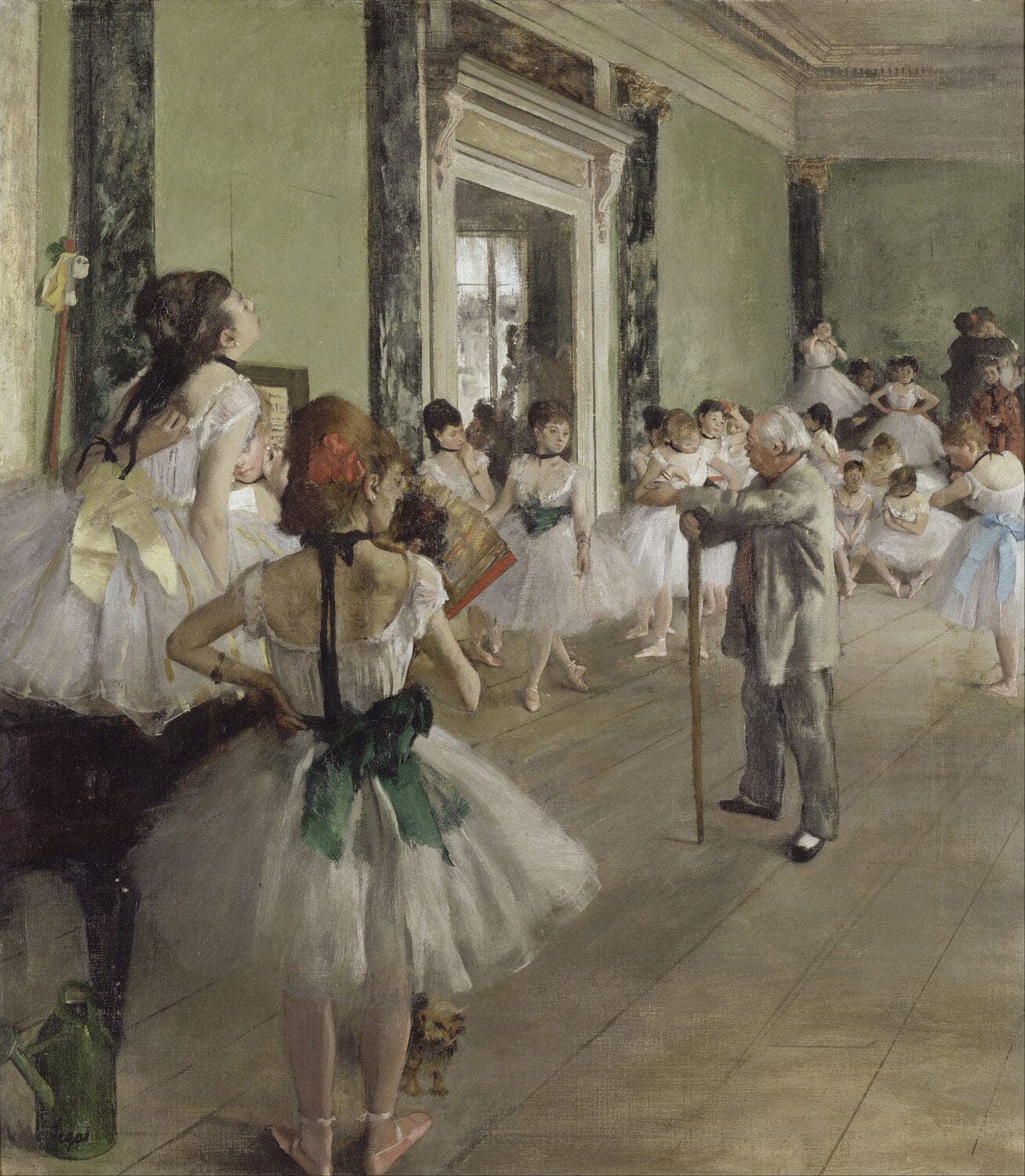Edgar Degas was a pioneering Impressionist painter whose works are still admired today.

Degas’ artwork is often associated with the Impressionist movement, but he was also exploring and pushing the boundaries of modern art. He used creative techniques such as wax sculptures, photography, and capturing movement and light in his paintings.
Degas’ life and work offer an interesting insight into both the Impressionist movement and early modernism. From his private studio sessions to the creation of iconic works such as The Ballet Rehearsal and A Cotton Office in New Orleans, his artistic journey allows us to explore a unique period in art history.
In this article, we will take an in-depth look at Edgar Degas’s life, work and influence on the Impressionist movement.
A Brief Biography of Edgar Degas
Edgar Degas was a French artist born in 1834. He was considered one of the early leaders of Impressionism, and his works explored themes of movement, human bodies at work, and the juxtaposition of light and dark. Degas received formal art instruction under Louis Lamothe, but ultimately chose to combine imagery with his own eye to create his signature style.
Degas’s subjects encompass a broad array of topics, from landscapes to abstract compositions. His works often reflect social changes taking place in the world around him. For example, he portrayed the advances in industry and technology that came with the shift from an agricultural-based economy to a more industrial one. In addition he created artworks which focused on ballet dancers, touring musicians and even laundresses—people whose lives were often ignored or overlooked in society at large.
By using light to highlight the backdrop of everyday life in France, Degas captured a unique perspective which has since been adopted by many other creators. His work has been credited with helping to elevate Impressionism as an artistic genre and inspiring generations of artists who follow in his footsteps today.
Exploring the Unique Impressionist Technique of Degas
Edgar Degas was an Impressionist painter who found success by bringing a unique twist to the well-known style. He was trained traditionally and created his own distinct esthetic by experimenting with color, light, and line. As he used charcoal drawing to create stunning effects and figure compositions, he expanded the brush strokes of the Impressionists.
The most noteworthy characteristic of Degas’s Impressionist style was his use of pastels. His limited use of bright colors gave his sketches a low-key but powerful edge, which allowed him to capture subtle details but also express movement. He favored blue hues as they allowed him to make quick strokes without defining every detail – a technique that is particularly evident in paintings such as ‘Dancers in Blue’ or ‘The Rehearsal Room’. Degas also introduced the use of monotypes, making multiple copies from an etched plate and combining pastels with the print for a soft finish.
In the end, it is these techniques that made Degas stand out from other painters of his type and century. His unique approach left an indelible mark on Impressionism and even 19th century art history more broadly.
Major Works of Art From the Degas Collection
Edgar Degas was known for creating stunning works of art that have since become famed masterpieces. He created many different kinds of work with a variety of media, but the most well-known pieces were his paintings and sculptures. Here’s a look at some major works from the Degas collection:
The Laundress
One of the most famous paintings by Edgar Degas is The Laundress, created in 1883-1884. This painting depicts a woman doing laundry, with her back to the viewer. This piece is indicative of Degas’s focus on everyday life and scenes within Parisian culture in the 1800s.
A Cotton Office in New Orleans
This oil painting was created by Degas between 1873 and 1876 and appears to represent his observations of cotton traders in New Orleans. This piece captures everyday experiences, such as people interacting with their work environments and preparing for the trading day ahead.
Ballet Dancer in Repose
Degas is known for his interest in ballet dancers, which can be seen across several pieces including Ballet Dancer in Repose. This piece was created around 1872 and depicts a dancer stretching themselves after practice or rehearsal. The use of shadow provides an interesting effect on this painting, which showcases Degas’s skill as an artist.
How Degas Has Influenced Modern Art
Edgar Degas was a key figure in the development of Impressionism, but his contributions and influence can still be seen today. His works are considered the bridge between Realistic painting and modern art, making him a pivotal part of art history.
Degas’ blending of traditional art forms with innovating techniques and materials helped to set the stage for the next generation of artists. He employed new methods such as painting with both thick and thin brushstrokes, layering paint in a way that was both daring and effective, introducing bright colors into his palette and manipulating light and shadow to bring emotion to life on canvas.
His use of line and composition had an especially profound impact, often featuring geometric forms that conveyed a sense of movement and tension in his works – something that has been carried forward into modern art. His love for portraiture also paved the way for more contemporary work that focuses on capturing emotion through faces alone.
Through his innovative style, Edgar Degas has made an indelible mark on modern art – one that continues to inspire new generations of impressionists.
Exhibitions and Museums Dedicated to the Artist
Edgar Degas is celebrated around the world — and it is not difficult to find evidence of this. Many art galleries, museums, and even entire institutions dedicate their focus solely to the Impressionist’s works.
The Musée d’Orsay
Located in Paris, France, the Musée d’Orsay has an extensive collection of Degas’s sculptures, drawings and paintings. Examples of his best works can be found there – the iconic painting ‘The Dance Class’ among them. Along with the pieces on display, visitors can learn more about Degas’ life and work through interactive displays and exhibitions that shed light on his process and techniques.
The Degas House Museum
The Degas House Museum is located in New Orleans, Louisiana—the city where Edgar Degas’s father was born. It is dedicated to preserving both his works and his legacy as a painter who helped shape Impressionism. The museum houses the artist’s studio, along with a collection of more than 200 original artworks from Degas’s family; most notably those by Edgar himself.
Visiting either of these institutions allows one to gain a deeper understanding of the artist’s life; from the relationships he had to his creative process—all while being surrounded by masterful works of art created by him.
Creative Materials Used by the Artist in His Paintings
The creative materials used by Edgar Degas in his paintings were revolutionary for their time. His dislike of the traditional oil paint helped shape him as an Impressionist, since he preferred to use bold, unusual techniques in place of the typical muted styles of the period.
Colorful Experiments
Degas experimented with both traditional and non-traditional materials, often combining them to create unique effects. He was known for utilizing pastels and wax crayons to achieve vibrant colors. He also used charcoal and pastels to manipulate light and shadows in his paintings, which created a dramatic style that was distinct from other artists. In some pieces, he even embedded small objects such as bronze foil into the paint itself!
Focusing on Detail
In addition to his use of interesting materials, Degas was famed for his attention to detail. He was meticulous in his brushstrokes, often working in small sections at a time, experimenting with different ways to render a scene or a figure with precision and realism. His work included many close-up perspectives that revealed intricate details previously unseen in painting before him.
The creative approach taken by Degas in employing materials served as an inspiration to other Impressionist painters throughout art history — making him one of the most influential Impressionists of all time!
Degas’s innovative approach to painting had a lasting impact on Impressionism and paved the way for modern art of the 20th century. Through his experiments with color, light and composition and his attention to detail, he achieved an unparalleled level of realism. His ability to capture the elusive moments of everyday life will continue to inspire and charm generations of viewers and art lovers. By exploring his life and work, Degas can continue to teach us about the beauty of art and the power of humanity.
